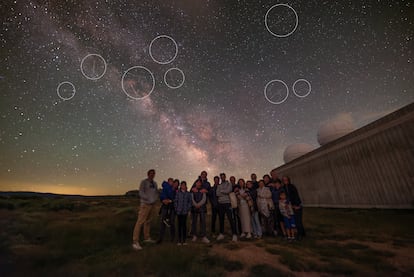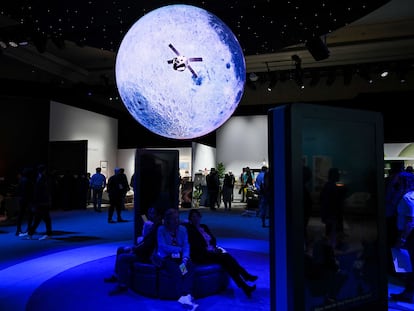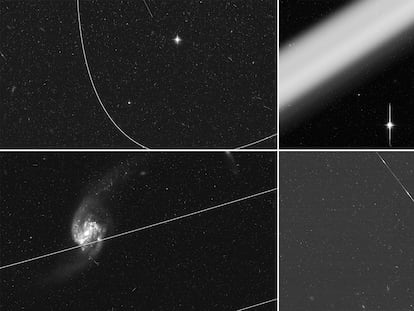Boom in satellites changes the sky forever
The new global internet operators plan to launch half-a-million satellites by the end of this decade. These objects alter astronomical observations and inject pollutants into the atmosphere, resulting in potential risks for the ozone layer
Astronomers have classified a new object among the brightest in the sky. It’s not a star or a planet: it’s BlueWalker 3, the prototype for a new fleet of dozens of satellites that will provide a 5G connection from space.
Achieving the technological goal of being able to be connected anywhere on the planet is leading us to cross another frontier. After changing many landscapes and altering the climate of the entire planet, human civilization is also transforming the appearance of the night sky.
In the eyes of anyone — not just astronomers — looking up at the sky began to feel radically different in 2019. That year, Elon Musk’s SpaceX company began deploying Starlink, the largest of the so-called satellite megaconstellations. They are being placed into orbit by new operators that offer global high-speed internet coverage (among them are Amazon and OneWeb). Today, these types of satellites have broken their brightness record. According to a study published by the scientific journal Nature, if we considered BlueWalker 3 to be a star, it would be among the 10 brightest of the total of 9,096 stars that can be seen with the naked eye.
The authors of the study warn that the current uncontrolled proliferation of these artificial stars is a risk for science. ”All branches of observational astronomy can be affected. Despite the measures we’re taking, these satellites can be confused with variable astronomical objects, or [they can] leave remains in our data that have unexpected repercussions,” says Meredith Rawls, who participated in the research. She’s a research scientist in the Department of Astronomy at the University of Washington.
Additionally, the astronomical community is beginning to study the environmental impact of these satellites. Given the forecast that, in a few years, there will be hundreds of thousands of these satellites in low Earth orbit, there’s concern that they contain materials that can damage the ozone layer.
For those who become interested in astronomy, these changes in the sky are a new element, making it more dynamic. The spectacle offered by a very dark night sky no longer just contains stars and planets that are standing still. We now also see numerous satellites… and only their movement allows us to distinguish them from the natural stars.
The astrophysicist Borja Tosar explains that “satellites don’t shine because they have their own light, but rather, because they reflect the light of the Sun. They’re built with highly reflective materials and, therefore, although they’re very small (a Starlink satellite’s core is about the size of a washing machine) we see them as being as bright as the gigantic stars that are located several light years away.” Tosar highlights how the Starlink satellite trains draw attention, moving in a line during their ascent to their final orbit, at an altitude of 340 miles. “They arouse a lot of curiosity and, frequently, I receive reports from people who witness this phenomenon and believe they’ve seen a UFO,” the expert chuckles.
Mobile astronomy apps — as well as websites such as Heavens-Above — are used by amateurs and professionals alike to know precisely when a satellite such as BlueWalker 3 is passing by. This information is very useful, both for those who go hunting for these artificial stars and for those who try to avoid them.
Óscar Blanco is in need of help in both of these departments. In Ourense, Spain, he teaches visitors to the Trevinca Astronomical Center about how to identify satellites and stars. At the same time, he tries to avoid the streaks left by the satellites in his astrophotographs. Capturing these images requires a few seconds, which results in the moving dots of the satellites becoming streaks across the sky.

“Fortunately, astrophotographers have computer programs that can erase these satellite traces. But to do this, you need to take several images… and [the streaks] cannot always be eliminated,” Blanco laments. The alterations caused by the satellites — which, in the summer, are visible almost all night long and reach a considerable height above the horizon — demonstrate the interference that the new megaconstellations can pose for astronomical research.
From the Atacama Desert in Chile, Jeremy Tregloan-Reed dedicates himself to the study of exoplanets. He’s one of the main authors of the scientific article on the brightness of BlueWalker 3. He decided to become involved in this research “because there was talk that it would be the beginning of the end of astronomy, when it was deployed in November 2022. But the same thing was also said when we began to see the flashes of the Iridium satellites, at the end of the 20th century.”
BlueWalker 3 and the end of astronomy
Tregloan-Reed maintains that, overall — and at the moment — it doesn’t seem like a big problem. But it can become one “if proliferation isn’t controlled and action isn’t taken to reduce the amount of sunlight reflected by satellites. The passage of a satellite with a brightness that’s greater than the recommended limit of magnitude seven… could ruin an entire [series of images] taken by specific telescopes, such as that of the Vera C. Rubin Observatory [under construction in northern Chile].”
According to the results of Tregloan-Reed’s research, BlueWalker 3 reaches a brightness of magnitude of 0.4. The figure may seem reassuring, but it’s not. This implies that the satellite is 437 times brighter than recommended. The professor of astrophysics clarifies that the luminosity of celestial bodies is measured on an inverse scale. “The greater the brightness, the lower the magnitude number. And it’s also a logarithmic scale, so decreasing five units means that the object will be 100 times brighter.”
Experts agree that the problem isn’t this specific device, but rather that, by 2030, there are expected to be hundreds of thousands of satellites, launched by many different companies. BlueWalker 3 — which has broken records due to its gigantic 688-square-foot antenna — is just a test run for operator AST SpaceMobile’s new network, which will have about 90 satellites up to seven times larger, called BlueBirds. This would make them at least as bright as Sirius, the brightest star in the sky.
“The look of the night sky could change forever. There’s a risk that this view is dominated by moving satellites, rather than stars,” explains Mike Peel, from Imperial College London, who participated in the research published by Nature. “To avoid this, there’s the general recommendation [that the limit be a magnitude of seven], which implies a brightness fainter than the stars you can see from a dark sky site,” Peel emphasizes.
The International Astronomical Union (IAU) dedicated a symposium in the Canary Island of La Palma to this problem. The Spanish researcher David Galadí — member of the IAU commission that studies how satellite megaconstellations affect astronomy — explains that the impact on the environment was front and center at the meeting. “There’s considerable concern due to the effect on the atmosphere that the increase in satellite launches can have. Also, re-entries are a problem, since everything that goes up to low Earth orbit ends up falling down again.”
Studying the effects of satellites on the ozone layer
Maintaining these swarms of hundreds of thousands of satellites will mean that, every now and then, one will fall and disintegrate upon its re-entry into the atmosphere. Galadí warns that “this will inject vaporized foreign substances — such as aluminum— into the upper layers of the atmosphere at a rate up to 10 times higher than the natural contribution from meteorites. And the formation of aluminum oxides can affect the ozone layer.”
Given this theoretical possibility of damage to the ozone layer, Galadí points out that there’s a need for more research to quantify this impact. He criticizes the fact that the companies that launch satellite megaconstellations aren’t required by law to carry out environmental impact studies in the upper layers of the atmosphere. There’s an absence of international regulations that supervise the use of low Earth orbit. “It’s like the Wild West. They’re occupying a lawless territory and they can do whatever they want,” he sighs.
While research into this new type of environmental pollution is still in its early stages, the light pollution that this proliferation of satellites will bring has already been heavily studied. Tregloan-Reed warns that “even if all operators complied with the recommendation that their satellites have a maximum brightness [of a magnitude of seven] — and thus were not visible to the naked eye — they would contribute to increasing the background glow of the sky.” According to him, if the more than half-a-million satellites planned for 2030 become reality, this would erase the faintest stars that the human eye can detect. This risk is confirmed by data from a recent study by physicist Salvador Bará, which was published in Nature Astronomy. This effect will be more noticeable, as a matter of fact, in places that currently have a darker sky and offer the ideal conditions for stargazing.
For Meredith Rawls, this new form of light pollution is totally different from the usual one, from which we could escape by shifting to a location that is far from cities and villages. “However, satellites orbit around the entire planet. When all these megaconstellations are complete, there will be nowhere on Earth to escape to observe a dark, clean night sky,” she regrets.
Sign up for our weekly newsletter to get more English-language news coverage from EL PAÍS USA Edition

